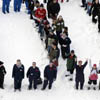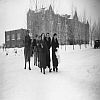Campus Life

There were 45 students enrolled at the University of Alberta for the 1908 to 1909 school year. Of those 45, seven were women. Ethel Anderson, student head of the women's athletics program, and the six other undergraduate women established Club SIS, where SIS stood for Seven Independent Spinsters.
In 1909, the members of Club SIS gathered and chose a name for themselves—a name that would be "of such a character, that it would be handed down to posterity." As a result of this meeting, the Wauneita Club was formed as a successor to Club SIS. All women students at the University automatically belonged to the Wauneita Club.
Although total enrollment was only 103 in the 1909-1910 school year, the Students' Council, the Literary Society, and the Athletic Association had already been founded. By 1913, sixteen others were added, including the Glee Club, the Orchestra, the Philoneician Debating Club, the Philosophical Society, and the Collegium Agricolarum.

In 1910, the student newspaper, The Gateway was founded. That same year, the University of Alberta Agriculture Club, also known as the "Aggies" or "Ag Club", was established. The Aggies were a very social group of people who held many events both on and off campus.
During World War I, the number of student societies increased, although some societies were disbanded. Among new additions were the Rifle Association, the Mathematics Club, the Modern Languages Club, the Tennis Club, the Women's Athletic Club, and the Harriers' Club.
In the years from World War I to the Great Depression, the development of student organizations was not affected by the increases in fees and living costs. The Canadian Officers' Training Corps is listed for the first time in the Calendar for 1922–1923. Beginning in 1924, the University availed itself of station CJCA for Extension broadcasts and, in 1927, began to operate its own station, CKUA. Students and staff maintained and worked the equipment.

The University's doors were opened in 1928–1929 to student fraternities and sororities when the decision was made to do away with the regulation which required students to declare that they did not belong to secret societies.
The University of Alberta Mixed Chorus traces its beginning to 1939, when a small choir was formed under the direction of Ottoman Cypress. Rehearsals and practices for the choir were organized for the fall of 1944, under the leadership of Gordon F. Clark; its first concert was held in Convocation Hall in February 1945.

Throughout the 1930s and 1940s, CKUA steadily grew. It continued to be owned and operated by the University of Alberta until 1944, when the Alberta government bought out its license. A sufficient number of students were interested in broadcasting so a radio club, the University of Alberta Student Radio Directorate, was created in 1946 to fill the void left by CKUA's departure. In 1948, the Radio Directorate changed its name to the Radio Society.
The first Bar None, the Agriculture Club's premier event, took place in the 1947–1948 academic year and was organized by Club President Urban Pittman and his executive colleagues. After a few years, Bar None moved to the Exhibition Gardens, known today as Northlands Park. The event still occurs at this venue today.
The opening of the Students' Union Building in 1950 provided a centre for student life on campus. In 1964, the first three new residences for undergraduate students, Mackenzie, Henday, and Kelsey Halls, and a large dining hall, Lister Hall, were opened. Athabasca Hall and Pembina Hall then became residences for senior undergraduate and graduate students, and Assiniboia Hall was used as office space for teaching departments.

In 1957, a group of about twenty students decided they wanted to learn how to dance. Deloyce (Tolonen) Burns was appointed president of the group, and small classes began in Latin American and modern North American dance. Several changes were made to the Club in the 1964–1965 school year. The name "Modern Dance Club" suggested interpretive dancing, in which the Club was not involved. The U of A Dance Club was eventually chosen as the new name. The Club celebrated its fiftieth anniversary in 2006–2007.
Dorothy Harris, a professor of dance at the University of Alberta, founded the U of A Orchesis group in 1964. Harris initiated a wave of creative dance in the mid-1960s that has taken on a life of its own in the present vibrant dance community in Edmonton.
In 1967, the University of Alberta began building a new Students' Union Building (SUB). When it was completed in 1968, the Radio Society moved its studio from University Hall into the new building. In 1970, the Radio Society made an application to the Canadian Radio-Television and Telecommunications Commission (CRTC) and became CKSR. The CK was from CKUA and the SR stood for "student radio".

Over the years, organizations such as the Humanities Association and the Philosophical Society were disbanded. Interest in the Wauneita Society also declined, and it ceased to be listed as an active organization in 1973. This did not mean, however, that interest in women's societies had waned. In the 1980s, an Alberta Chapter of the Ceres International Women's Fraternity was installed. The University of Alberta Women's Centre Collective saw its dream realized when the University of Alberta Women's Centre officially opened its doors on October 3, 2003.
Over the past 100 years, the number of student groups has increased from under a dozen to over 300 to reflect the wide range of interests of the over 36,000 students enrolled at the University of Alberta.